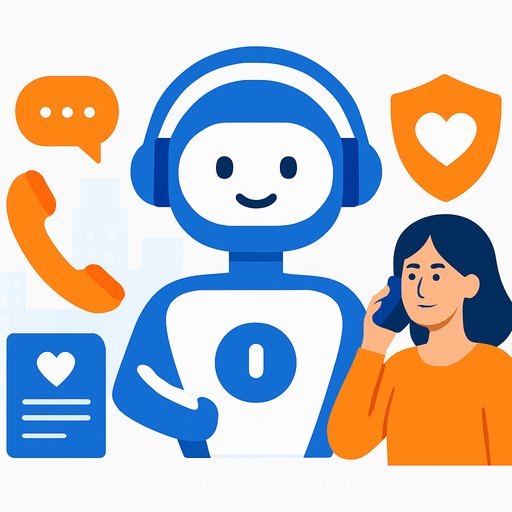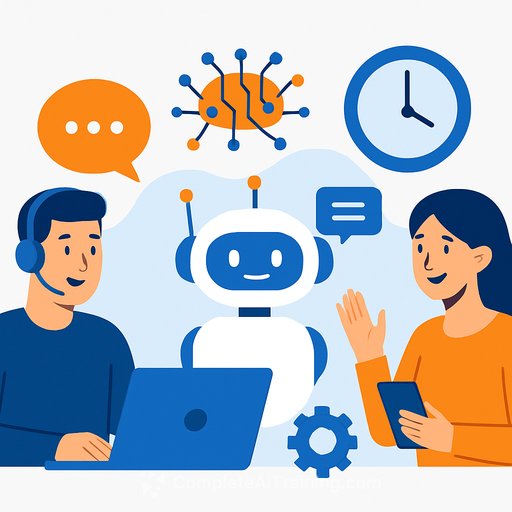AI Chatbots vs. Human Support: Speed Without the Connection?
AI chatbots are everywhere in support. They cut queues, handle high-volume questions, and keep costs predictable. The catch: customers still want to feel heard. Speed helps, but empathy earns trust.
Surveys and field data point to the same truth-many users get frustrated when conversations feel scripted or rigid. People will wait longer if the payoff is a real human who understands the context.
The Efficiency Paradox
Chatbots can resolve simple requests in seconds. But fast doesn't always feel good. Several reports show lower satisfaction for bot-led conversations compared to human-led ones, especially when the issue carries emotion or risk.
One analysis highlighted how bots are often agreeable by default, which can come off as shallow in tense scenarios like disputes or health advice. That gap between "friendly" and "genuine" is where loyalty erodes.
What the Data Suggests
- Customers rate bot interactions lower when they need emotional validation, not just an answer.
- Abandonment rises when users feel trapped in scripts or can't easily reach a person.
- Bots excel at routine tasks; they struggle with nuance, exceptions, and negative outcomes.
Research from firms focused on customer loyalty indicates that hybrid models-AI supporting humans-outperform bot-only approaches on trust and retention. For deeper context on loyalty mechanics, see this overview from Bain & Company.
Why Rejection Triggers Escalation
Denials are a breaking point. When a bot says "no"-refund not approved, policy exception denied-customers rarely accept the outcome. They want a human to review the situation and weigh context.
This is where bot "efficiency" backfires. A fast refusal without empathy feels hollow, sparks complaints, and increases escalations. The fix is straightforward: let bots triage and inform, but hand off decisions with emotion or money on the line.
Build a Hybrid Support Model That Customers Trust
Your goal isn't "bot first." It's "best resolution with the least friction." That means bots do the heavy lifting upfront, then pass the baton cleanly when nuance is required.
Smart Triage, Seamless Handoffs
- Classify early: Topic, intent, and sentiment within the first two messages. Set confidence thresholds to decide bot vs. human.
- Escalate on signal: Negative sentiment + denial, high-value accounts, legal/health/PII topics, or any second explicit request for a human.
- Label clearly: Always disclose "You're chatting with our virtual assistant." Offer a one-tap route to a person-no loops.
- Warm transfer: Send a concise summary, customer intent, attempted steps, and disposition to the agent so customers don't repeat themselves.
- Guardrails: No medical, legal, or financial advice beyond approved scripts. If uncertainty is high, route to an expert.
Bot Copy That Feels Human (Without Pretending)
- State capability: "I can help with order status, returns, and shipping. For billing disputes, I'll connect you with a specialist."
- Reflect emotion, then act: "I see why that's frustrating. I can start a return now or get a teammate if you prefer."
- Offer choices: Present two clear next steps to reduce friction and give control back to the customer.
- Own limitations: "I might miss context here. Want me to bring in a human?"
Agent-Assist: Your Quiet Multiplier
- Real-time suggestions: AI surfaces relevant policies, next-best actions, and knowledge snippets with confidence scores.
- One-click drafts: Suggested replies and summaries the agent can edit, not auto-send.
- Decision support: Refund calculators, goodwill guidelines, and risk prompts so agents can say "yes" with guardrails.
- Context memory: Pull recent orders, tickets, and sentiment so the agent sees the full picture at a glance.
Metrics That Matter
- Containment vs. Satisfaction: Don't celebrate containment if CSAT drops. Track both together.
- Escalations After Denial: Measure handoff rate and resolution quality when bots refuse requests.
- FCR and Recontact: Are customers returning within 7 days for the same issue?
- Effort Score: Count steps to reach a human, repeat explanations, and time-to-handoff.
- Agent Productivity: AHT with agent-assist vs. without, plus QA scores.
90-Day Implementation Checklist
- Weeks 1-2: Map top 20 intents, label 500-1,000 transcripts for sentiment and denial outcomes. Define handoff rules.
- Weeks 3-6: Launch bot for the top 5 intents only. Add clear "talk to a person" path. Enable warm transfers and agent-assist.
- Weeks 7-10: Review failure cases, especially denials. Improve copy, add exception pathways, and tune thresholds.
- Weeks 11-12: Expand to next 5 intents. Publish a "human in the loop" policy and update your help center.
Risk and Compliance Notes
- Transparency: Clearly label automated agents and log consent where required.
- Data minimization: Mask PII in bot logs. Limit retention. Route sensitive topics to humans.
- Quality review: Weekly audit of transcripts with denials, escalations, and complaints.
For a broader look at how bot-driven experiences shape consumer trust, this New York Times coverage offers useful context on why "agreeable" bots can still feel off in sensitive moments.
Practical Policies for "No" Scenarios
- Lead with options: Offer store credit, partial refunds, or repair before a hard denial.
- Explain the why: Short, specific policy language beats generic refusals.
- Offer recourse: "I can connect you with a specialist who can review exceptions."
- Track outcomes: Denial acceptance rate and post-denial CSAT by channel.
What's Next
Expect more pressure for transparency and clear handoff paths. As bots get smarter, the bar for trust gets higher, not lower. The winners will blend automation with real human judgment.
Bottom Line
Speed is table stakes. Empathy wins renewals, referrals, and patience when things go wrong. Use bots to reduce effort, not to avoid people.
If you're upskilling your team on practical AI for support workflows, explore Complete AI Training: Courses by Job for structured paths that pair automation with human-first service.
Your membership also unlocks:






